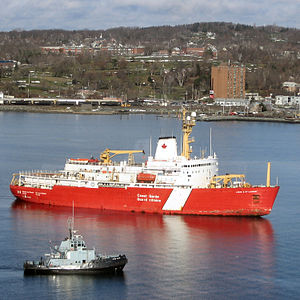(OTTAWA) — The government of Canada announced on Thursday that it will move forward with the construction of two polar icebreakers under the National Shipbuilding Strategy (NSS).
Both new polar icebreakers will have capacity and ability beyond that of Canada’s current largest icebreaker, CCGS Louis S. St-Laurent, and will both be built by Canadian shipyards. Early estimates are that the construction of these ships will generate approximately 300 jobs per vessel at the shipyards, and 2,500 jobs across the marine supply chain. The construction of these new ships is in addition to the $17.49 billion in contracts already awarded to shipyards large and small across Canada under the NSS that have resulted in the revitalization of Canada’s shipbuilding industry.
Seaspan Shipyards in Vancouver, British Columbia, which has proven its shipbuilding capability with the completion of the first class of large vessels under the NSS, will build one of the polar icebreakers. The other polar icebreaker will be built by Davie Shipbuilding of Levis, Quebec, pending the successful completion of the ongoing selection process as the third strategic partner for large ships construction under the NSS. Both shipyards are expected to be supported by many small and medium-sized Canadian businesses across the country, ensuring that the construction of these ships will be a historic, cross-country effort to help drive Canada’s economic recovery from COVID-19.
This procurement approach will ensure at least one polar icebreaker is delivered by 2030 when CCGS Louis S. St-Laurent is expected to retire from service. Precise timing of icebreaker delivery will be determined once shipyard agreements are in place.

With their enhanced capabilities, these larger, more powerful polar icebreakers will enable the Canadian Coast Guard to conduct year-round operations in Canada’s Arctic. Their greater endurance will ensure they can operate at higher latitudes for longer periods, and will allow the fleet to better support indigenous peoples and northerners, strengthen Arctic sovereignty, advance high Arctic science, and better respond to maritime emergencies.
Quick facts
• Canada’s Coast Guard currently has 18 icebreakers of varying sizes and capability, which is the second-largest icebreaking fleet in the world. The largest is CCGS Louis S. St-Laurent, which will continue to operate through the next decade.
• In 2019, the government of Canada announced an investment for the renewal of the Canadian Coast Guard fleet with funding of $15.7 billion for up to 18 new large ships, additional funding for up to six program icebreakers, as well as investments of over $2 billion in vessel life extension, refit, and maintenance work for the existing fleet.
• The government of Canada’s National Shipbuilding Strategy is a long-term, multibillion-dollar program focused on renewing the Canadian Coast Guard and Royal Canadian Navy fleets to ensure that Canada’s marine agencies have the modern ships they need to fulfill their missions, while revitalizing Canada’s marine industry, creating good middle-class jobs and maximizing economic benefits across the country.
• To date, three offshore fisheries science vessels (OFSV) and 18 small vessels have been delivered to the Canadian Coast Guard under the National Shipbuilding Strategy along with two refitted medium interim icebreakers.
• In 2019, the government of Canada announced its intention to add a third Canadian shipyard as a partner under the NSS, and launched the competitive process to select the new shipyard.
• Following an invitation to qualify (ITQ), Davie Shipbuilding of Levis, Quebec, is the only shipyard that pre-qualified to become the third strategic partner under the strategy. Davie Shipbuilding moved to the next stage in the selection process, the request for proposal and evaluation stage.
Subject to Davie’s successful completion of the qualification process, the government of Canada will then begin negotiations for an umbrella agreement which is expected to be in place in late 2021.
– Canadian Coast Guard
